Ijraset Journal For Research in Applied Science and Engineering Technology
- Home / Ijraset
- On This Page
- Abstract
- Introduction
- Conclusion
- References
- Copyright
Phytochemical Estimation of Ethno- Medicinal plant of Asparagus racemosus willd. of Dang area of Dholpur District, Rajasthan (India).
Authors: Dr. Manoj Kumar Meena
DOI Link: https://doi.org/10.22214/ijraset.2024.58434
Certificate: View Certificate
Abstract
The present work was undertaken to analysis of the phytochemical compounds present in the root, fruit and bark of ethnomedicinal plant of Asparagus racemosus willd. belonging to Liliaceae family in dang area of Dholpur district of Rajasthan. Ethnomedicinal plants have bioactive compounds such as alkaloids, flavonoids, steroids and phenols which are used to curative various human ailments and also play an important role in healing.
Introduction
I. INTRODUCTION
The ethnomedicinal plants are useful for therapeutic as well as for curing of human diseases because of the existence of phytochemical compounds. Phytochemicals are naturally stirring in the medicinal plants, leaves, vegetables and roots that have protection mechanism and protect from various diseases. Mainly phytochemicals are two types - primary and secondary compounds. Chlorophyll, proteins and common sugars are incorporated in primary constituents and secondary compounds have terpenoid, alkaloids and phenolic compounds. Terpenoids show confirmation of various vital pharmacological activities i.e. anti-inflammatory, anticancer, anti-malarial, inhibition of cholesterol synthesis, anti-viral and anti-bacterial activities. Alkaloids used as anesthetic agents are found in medicinal plants. Plant chemicals are regarded as secondary metabolites because the plants that manufacture them may have little need for them. They are synthesized in all parts of the plant body like bark, leaves, stem, root, flower, fruits, seeds etc. Currently, the global demand of herbal medicines is increasing rapidly because of their higher safety margin and low cost. The current study exposed the qualitative phytochemistry of medicinal plant used by the peoples of Dholpur district, Rajasthan in curing dreadful ailments of human on one hand and cattle on the other hand.
II. STUDY AREA
Dang area is one of the most resource dispossessed and arid region of Rajasthan state marked with degraded ravines, barren land and severe water shortage. Dholpur district with an area of 3034 square kilometers is located in eastern most extremity of the state of Rajasthan and lies between latitudes 22o21’19” and 26o57’33” North and longitude 77o13’06” and 78o16’45” East.
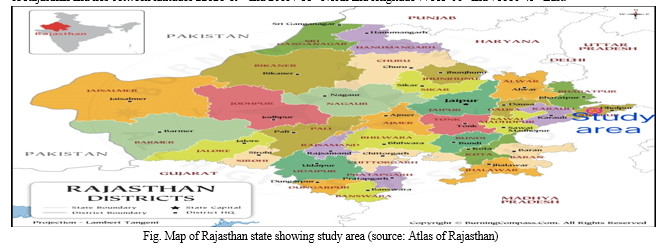


B. Preparation of plant extract
Collected plant material roots were washed with distilled water and shade dried for a week. The dried sample were manually ground to fine powder using pulverizer and passed through 40 mesh sieve and stored in air tight containers. The plant powder was taken in a test tube and distilled water was added to it such that plant powder saturated in it and shaken well. The solution was then filtered with the help of filter paper and filtered extract of the plant samples were taken and used for further phytochemical analysis.
- Flavonoids Shinoda’s test: 1ml of herbal extract was treated with few Mg turnings and a few drops of conc. HCl. Formation of pink / green color indicated the presence of flavonoids.
- Dragendroff’s test for Alkaloids: 2 ml of HCl was added to 0.5 ml of herbal extract followed by 1 ml of reagent. An orange red precipitate formation indicates the presence of alkaloids.
- FeCl3 test for Tannins: Few drops of FeCl3 solution were added to 1ml of herbal extract. configuration of blue or green color indicated the presence of tannins.
IV. RESULT AND DISCUSSION
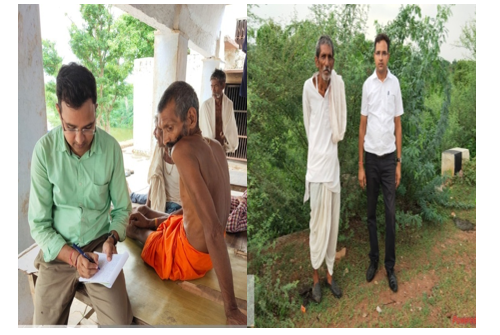
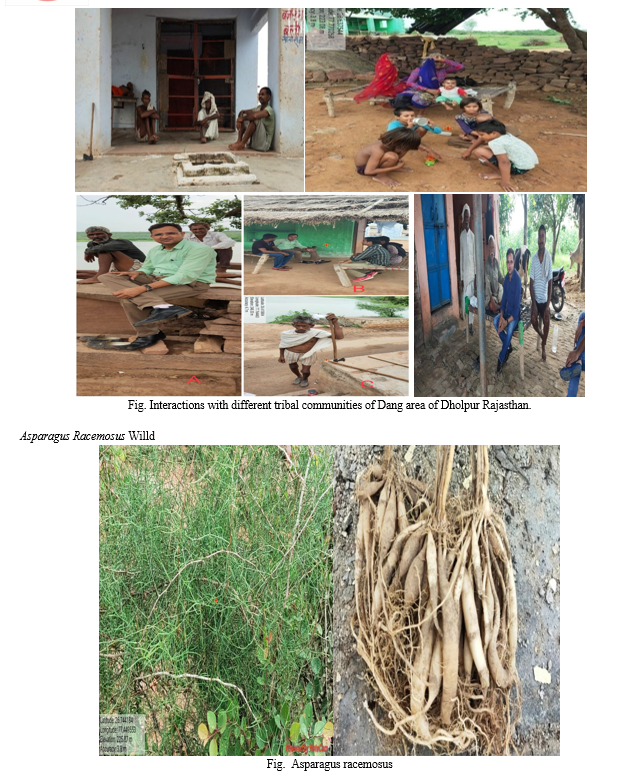
A. Medicinal Properties
Asparagus racemosus is used as herbal drug according to information of local people of dang region of Dholpur district. A. racemosus supplementation and its effect on digestion, udder, milk production and energy metabolism, reproductive health, blood metabolites and immune system of dairy cows. The tribals used powder of this plant root mainly for galactagogue. In addition this plant is also recommended by local people for dyspepsia, curing of peptic ulcers, certain infectious disorders, nervous system diseases, diarrhoea, inflammation and liver problem. It has important use to augment immunity against pathogens like fungi, helminthes, protozoa, virus and bacteria. For joint stiffness, it is highly used. Its root is effective for antispasmodic, aphrodisiac, demulcent, diuretic and refrigerant. Combination of its root has more application for instance boiling of root with rice bran oil can inhibit several skin problems and with milk, it is used with Shatavari that is a crucial herbal drug in ayurveda to prevent women problems such as fertility. Its rhizome part is applied as soothing tonic, which has efficacy to respiratory system, circulatory system, female reproductive organs and digestive system. Asparagus racemosus is utilized for threatened miscarriage, loss of libido, stomach ulcer, hyperacidity, bronchial infection and menopausal problems. Application of whole plant has given more positive results to cure rheumatism, brain complaints and diabetes milletus, as well as management of behavioral disorder and minimal brain dysfunction.
B. Phytochemical Analysis
Some phytochemical compounds such as flavonoids, alkaloids, steroids, tannins, and phenol were analyzed from Asparagus racemosus roots.
C. Flavonoids
Phytochemical screening of flavonoid present in selected plant with standard showed various medicinally active constituents . In Asparagus racemosus there were two fractions FR II and FR III in which brown color with 0.87Rf valuein FR II and bright grey with 0.26Rf value in FR III was observed, compounds found in qualitative analysis of Asparagus racemosus root was kaempferol and rutin.
Table-13 Chromatographic and physico-chemical characteristics of isolated flavonoids from root of Asparagus racemosus
|
Isolated compounds |
Rfvalue |
Physical appearance |
Color after spray |
|||
|
S1 |
Daylight |
Ammonia |
I2 Vapor |
R1 |
||
|
Visible |
||||||
|
Kaempferol |
0.87 |
Green-Yellow |
Bright-Yellow |
Yellow- Brown |
Brown |
|
|
Rutin |
0.26 |
Green-Yellow |
Yellow |
Yellow- Brown |
Bright-Grey |
|
Abbreviations: S1 – Benzene: acetic acid: water (125: 72: 3), R1 – 5% FeCl3 solution.
D. Alkaloids
In the present study, alkaloids extracts was applied on TLC plates separately and compared their color and Rf values with standards. Alkaloid estimation showed one spot of brick red color in FR II and FR III fractions and found that they were nearby values to Rf value of trigonelline compound.
Table- Chromatographic and Physico-chemical characteristics of isolated trigonelline
|
Isolated compounds |
Rfvalue |
In UV |
Color after spraying and heating |
|
S1 |
R1 |
R2 |
|
|
Trigonelline |
0.11 |
BT-BL |
BK-RD |
Abbreviations: S - Butanol:Acetone:Water (4:1:5), R1-In UV, R2 -Dragendroff’s reagent, BT - Bright, BL – Blue, BK- Brick, RD- Red.

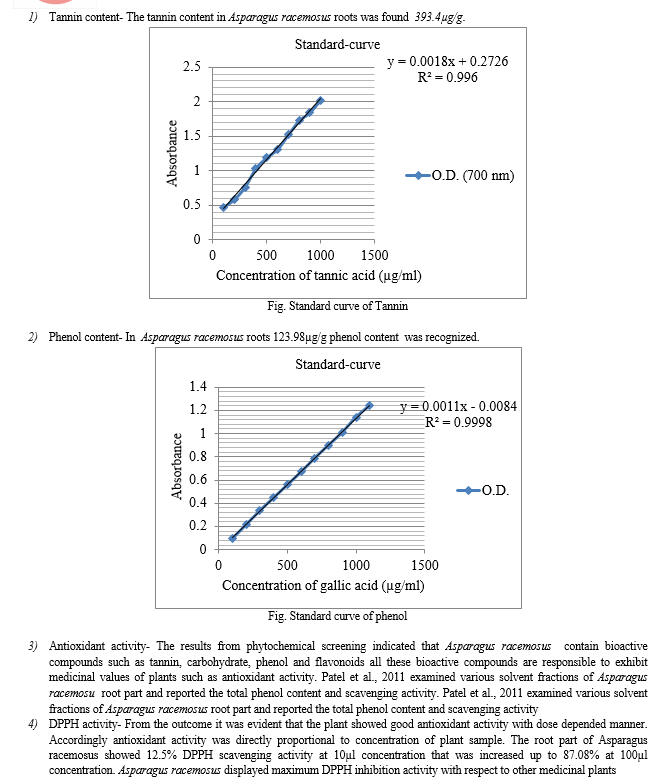
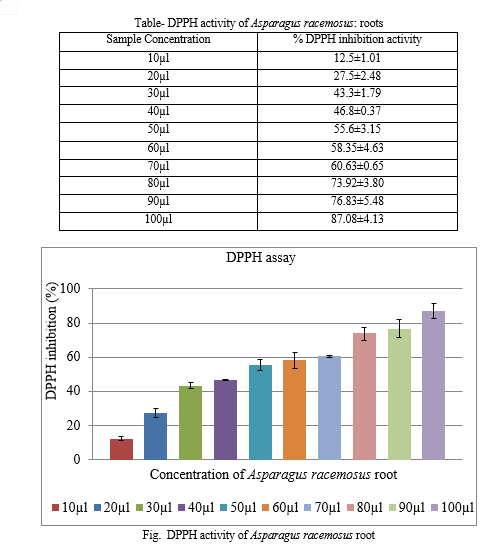
The current cram was undertaken to estimation the phytochemical compounds present in the roots of medicinal plant of Asparagus racemosus in Dang area of Dholpur district. Following investigations of extracts from Asparagus racemosus showed the occurrence of diosgenin and β-sito-sterol. In the study Diosgenin and Tigogenin with green and orange color spots were found from Asparagus racemosus. Extracts were organized as of aqueous and organic solvent like Petroleum ether, Chloroform, Ethyl acetate and Ethanol. Remedial plants have bioactive compounds which are used for remedial various human ailments and also play an vital role in healing. Analysis of the plants was performed using customary methods and resulted in the exposure of the presence of tannins, flavonoids, phenolics, saponins, steroids, and alkaloids.
It is expected that the important phytochemical properties acknowledged in the present study in the indigenous medicinal plants of dang area of Dholpur will be positively helpful in the curing of different diseases of the region.
V. ACKNOWLEDGEMENT
I would like to express my sincere gratitude to M.S.J. Govt. College for their unwavering support and provision of resources throughout the course of this research. and mentorship provided by Dr. Sanjay Kumar sir. Their constructive feedback and insightful suggestions played a important role in my research paper.
Conflict of Interest – The author declare that is there is no conflict of interest.
Conclusion
The phytochemical study of Asparagus racemosus willd. revealed valuable information about the chemicals present in the root parts of the plant. Plants also have bioactive components which have medicinal properties (Shakya, 2016). The various chemical tests showed the presence of Flavonoids, alkaloids, steroids, terpenoids and carbohydrates.
References
[1] Adeoti TK, Oyedapo (2012) Biochemical effects of saponins isolated from Momordica charantia. Med Chem & Drug Disc 3: 65-70. 35. [2] Ambi, A.A., Abdurrahman, E.M., Sule, M.I., Pateh, U.U., Abdurrahman, Y.R. and Ibrahim, N.D.J. 2007. Phytochemical screening and histopathological studies on the seeds of Colocynthis citrullus in albino rats. J. Pharmaceutical Sciences. 6(2):7-12. [3] Arora, R.K. 1987. Ethnobotany and its role in domestication and conservation of native plant genetic resources. In S.K. Jain (Ed.) A. Manual of Ethnobotany. 2nd ed. Scientific Publishers, Jodhpur. 94-102 [4] Bhattacharyya, R., S. Bhattacharyya, & S. Chaudhuri. 2006. Conservation and documentation of the medicinal plant resources of India. Biodiversity and Conservation. 15:2705–2717. [5] Jayaraman, R. and Christina, A.J.M. 2013. Evaluation of Solanum xanthocarpum fruits on in vitro antioxidant activity and in vivo DEN/PB induced hepatotoxicity. Int. J. Applied Res. in Nat Pro. 6(1):1-9. [6] Jain S. and Mogra R. (2006). Analysis of Food and Components, Department of Food and Nutrition, Maharana Pratap University of Agricultural and Technology, Udaipur (Raj.), India. [7] Joshi S. and Sharma M. (2013). Ethno-medicinal plants used in Birth Control by tribals of Kota region of Rajasthan”,Indian J. Applied & Pure Bio. 28(2). 237-243. [8] Kapoor B. B. S. and Lakhera S.(2013). Ethnomedicinal plants of Jodhpur District, Rajasthan used in herbal and folk remedies. Indian J.Pharm.Biol.Res 1(4) 71-75. [9] Katewa S.S. and Guri B.D. (1997). Ethnomedicinal observations on certain wild plants from southern Aravalli hills in Rajasthan,Vasundhara. pp. 85-88. [10] Kumar, S., Kumar, D., Manjusha, D., Saroha, K., Singh, N. and Vashishta, B. 2008. Antioxidant and free radical scavenging potential of Solanum xanthocarpum (L.) Schrad. Methanolic fruit extract. Acta Pharm. 58:215-220. [11] Maatooq, G.T., El-Sharkawy, S.H., Afifi, M.S. and Rosazza, J.P. 1997. C-hydroxy-benzoyl-glycoflavones from Solanum xanthocarpum. Phytochemistry. 44 (1):187-90. [12] Murthy, H.N., Yadav, G.G. and Dewir, Y.H. 2021. Ibrahim Phytochemicals and Biological Activity of Desert Date (Balanites aegyptiaca (L.) Delile).Plants 2021, 10:32. Structural and Functional Analysis of Extracts in Plants. 415. [13] Othman, S.S., Hamad, G.M., Zaid Hassan, S.A., Fayad, E. and Ali, S.M. 2022. Preparation, Identification and Antioxidant Evaluation of Solanum xanthocarpum Root and Fruit Extracts against Doxorubicin in Male Rats. Online J. Biological Sciences. 22(1):75-86. [14] Patel, D., Laloo, D., Kumar, R. and Hemalatha, S. 2011. Pedalium murex Linn.: An overview of its phytopharmacological aspects. Asian Pacific J.Tropical Medicine. 4:748-55. [15] Patel, D.K., Laloo, D., Kumar, R., and Hemalatha, S. 2011. Pedalium murex Linn-An overview of its phytopharmacological aspects. Asian Pacific J. Tropical Medicine. 412-420. [16] Priyavardhini, S., Vasantha, K. and Umadevi, M. 2009. Antibacterial activity on Solanum xanthocarpum leaf extract. Ancient Science of Life. 29(1):12. [17] Rodge, S.V. and Biradar, S.D. 2013. Preliminary phytochemical screening and antimicrobial activity of Solanum xanthocarpum (Linn.) Schard. Ind. J. Plant Sci. 2(1):19-23. [18] Singh, V. and Pandey, R.P. 1980. Medicinal Plant lore of the tribals of eastern Rajasthan (India). J. Econ Taxon Bot.1:137-147. [19] Shekhawat D. and Batra A. (2011). Household Remedies of Nainwa Tehsil in Bundi District, Rajasthan. International Journal of Pharmaceutical Innovations 1(1). [20] Sturm, S., Schneider, P., Seger, C. and Stuppner, H. 2009. Analysis of Solanum xanthocarpum cucurbitacine derivatives with HPLC-SPE-NMR. Scientia Pharmaceutica. 77(7):254 [21] Thakar, H.K. and Chaudhary, B.L.2004. Folk herbal veterinary medicines of Southern Rajasthan. Ind. J. Traditional Knowledge. 3(4):407-418. [22] Viswanathan, M.B. 1997. Ethnobotany of the Malayalis in North Arcot district, Tamil Nadu, India. Ethnobotany. 9:77–79. [23] Vyas, M.S. (1987). Ferns and fern- allies of Rajasthan ethnobotanical and biochemical analysis. Ph.D. Thesis. Jai Narayan Vyas University, Jodhpur. [24] Patel, D., Laloo, D., Kumar, R. and Hemalatha, S. 2011. Pedalium murex Linn.: An overview of its phytopharmacological aspects. Asian Pacific J.Tropical Medicine. 4:748-55. [25] Patel, D.K., Laloo, D., Kumar, R., and Hemalatha, S. 2011. Pedalium murex Linn-An overview of its phytopharmacological aspects. Asian Pacific J. Tropical Medicine. 412-420. [26] Wong, E. and Francis, C.M. 1968. Flavonoids in genotypes of Trifolium subterraneum: I. The normal flavonoids pattern of the geraldton variety. Phytochem. 7:2123-2129. [27] Yudharaj, P., M. Shankar, R. Sowjanya, B. Sireesha, E. Ashok Naik, R. and Jasmine Priyadarshini 2016. Importance and uses of medicinal plants- An overview; Int. J. Preclinical & Pharmaceutical Research. e-ISSN 2249-7552.; 7(2): 67-73. [28] Zafar, R. and Gupta, M. 1989. Flavone from stem and fruit of Pedalium murex. Indian Drugs, 27(3):202.
Copyright
Copyright © 2024 Dr. Manoj Kumar Meena. This is an open access article distributed under the Creative Commons Attribution License, which permits unrestricted use, distribution, and reproduction in any medium, provided the original work is properly cited.

Download Paper
Paper Id : IJRASET58434
Publish Date : 2024-02-14
ISSN : 2321-9653
Publisher Name : IJRASET
DOI Link : Click Here
 Submit Paper Online
Submit Paper Online

